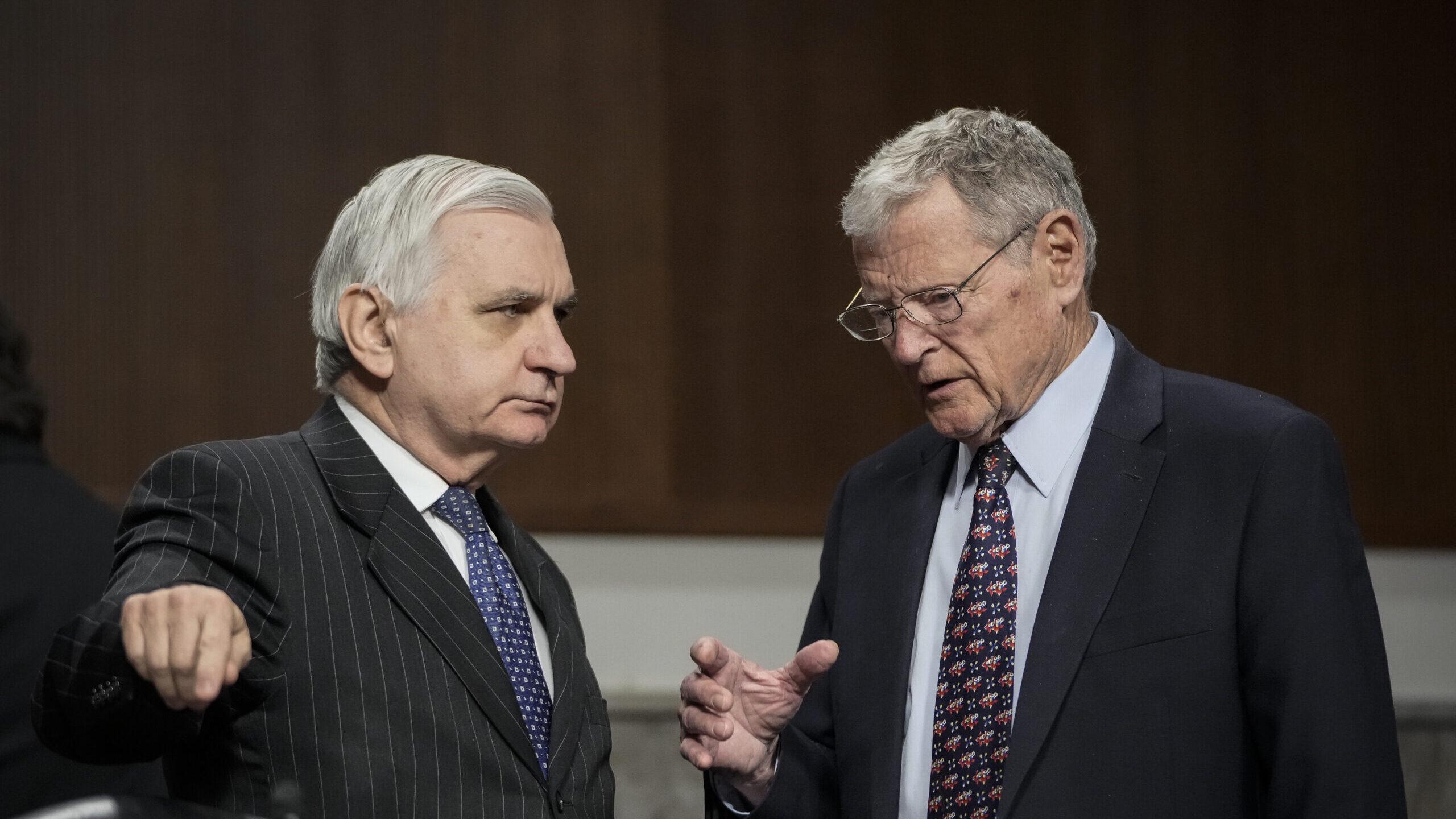
Committee chairman Sen. Jack Reed (D-RI) talks with ranking member Sen. James Inhofe (R-OK) before the start of a Senate Armed Services hearing on Capitol Hill March 15, 2022 in Washington, DC. (Photo by Drew Angerer/Getty Images)
WASHINGTON: The Senate Armed Services Committee wants to increase national security spending by some $45 billion over what the Biden administration has requested, bringing the total price tag for its proposed National Defense Authorization Act up to $847 billion.
The topline jump was to account for inflation, security assistance to Ukraine and to help replenish stockpiles of American weapons, among other expenditures, committee chairman Sen. Jack Reed, D-R.I., and ranking member Sen. Jim Inhofe, R-Okla., told reporters in a briefing ahead the release of a summary of the bill [PDF] today.
The legislation “confronts China and Russia by fully investing the Pacific Deterrence Initiative, the European [Deterrence] Initiative and the Ukrainian security assistance initiative,” Reed said. The summary says it authorizes $800 million in fiscal 2023 for security assistance to Ukraine.
The total national defense topline would sit at $857.64 billion after including more than $10 billion in defense-related provisions outside NDAA authority, according to the summary.
Key lawmakers have been signaling to expect a defense spending hike from almost the moment the department’s budget request was released in March — even though the Pentagon’s budget request was the highest in history. Whether the defense spending bill would jump as a result of inflation has been something of a political sticking point, with mostly Republican critics arguing national inflation had diminished the Pentagon’s buying power by the billions.
OP ED: How the Pentagon’s bad inflation math made a hollow budget
Inhofe suggested to reporters today he was optimistic the $45 billion increase would find support among his Republican colleagues, many of whom he said had input in the funding negotiations.
Last week the House Appropriations subcommittee on defense rejected a large hike, keeping their version of the funding bill for defense-related activities at $762 billion, in line with President Joe Biden’s request. Still, House Armed Services Committee Chairman Adam Smith, D-Wash., told reporters earlier this week he’d expect the topline of the House NDAA to increase as negotiations play out.
RELATED: ‘Not making ****ing widgets here’: Smith defense acquisition process
The summary of the SASC bill lays out in more detail where the staggering sum of money is being spent and the strings that come attached to it. It directs the creation of a “cross-functional team” to coordinate DoD efforts aimed at meeting the “security challenges posed by China” and includes $1 billion for the National Defense Stockpile “to acquire strategic and critical minerals currently in shortfall.”
The services will likely be pleased it also increases funding for major weapons programs, from the procurement of combat aircraft to armored fighting vehicles and naval vessels, as well as a range of items on the services’ unfunded priorities lists. It authorizes large bumps in funding for “game-changing technologies like microelectronics, hypersonic weapons, and low-cost attritable aircraft.”
Along with the money for hypersonic development, it also calls for a big boost in funding for counter-hypersonic technology — nearly $300 million for the Pentagon’s glide-phase interceptor initiative.
For close followers of the Pentagon’s sprawling JADC2 efforts, the legislation provides $245 million, that includes the establishment of a joint force headquarters in the Indo-Pacific.
As expected, lawmakers want to force the Navy to keep several ships in the fleet it would rather retire, specifically the bill prohibits the early retirement of 12 ships in FY23, including five littoral combat ships. It provides $25 million for research into sea-launched cruise missiles. As for space, the bill directs a study of Space Force’s component structure.
On the personnel side, it also authorizes a 4.6% pay increase for servicemembers and Pentagon employees. And it includes the controversial provision that women must register for Selective Service.
In his remarks, Inhofe, who is retiring and for whom this year’s bill is named, praised what he said was the bipartisan nature of the defense spending negotiations.
“So it’s something that’s done right, something has the support — has always had the support, historically — of all the members, and it’s surprising how non-partisan it has been in the past,” he said. “I’m not talking about just this year. This year yes, but also last year and the year before.”






















